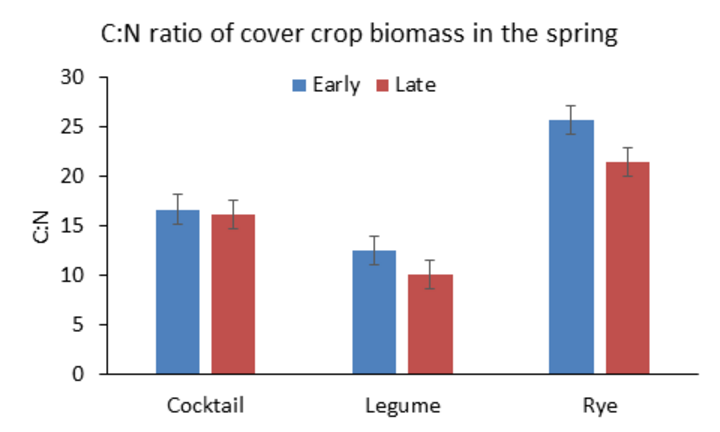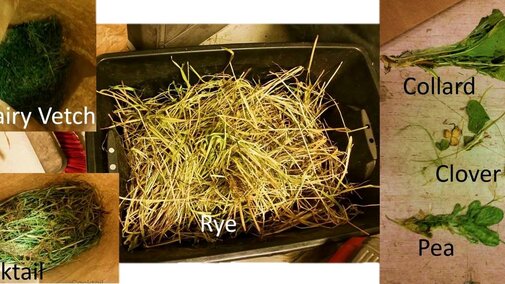By Natalie Holste, Biological Sciences Student, Missouri University of Science and Technology, and 2016 University of Nebraska-Lincoln Experiential Fellow
Advisors: Katja Koehler-Cole, Post-Doctoral Research Associate, and Roger Elmore, Extension Cropping Systems Agronomist, both in the Department of Agronomy and Horticulture
Introduction
Cover crops grown after primary crops can reduce costly nitrogen losses by taking up soil nitrogen into their biomass. After these cover crops are killed, soil microorganisms decompose their residue, using their carbon as an energy source and their nitrogen to build protein. A carbon to nitrogen (C:N) ratio of 24:1 is best for soil microbes. At higher C:N ratios, such as in later growth stages of cereal crops, microbes will take N from the soil for their growth. This lowers the soil N available to crops. At lower C:N ratios, like those found in legumes, microbes will release (mineralize) N, making it available for crops.
In our study, we wanted to investigate whether the species and age of the cover crop affected the C:N ratio, percent N, and total N in the aboveground biomass of cover crops. This research was part of an ongoing cover crop research project funded by the Nebraska Corn Board and Nebraska Soybean Board.
For this study cover crops (cereal rye, legumes, and a cocktail mix) were grown at the UNL Agricultural Research and Development Center near Mead. They were planted either early (early September) or late (mid-October after crop harvest). Above-ground cover crop biomass was sampled in mid-April when cover crops were terminated. Cover crop biomass was dried (Figure 1), weighed, and analyzed for percentage of carbon and nitrogen. To find the total nitrogen content of the cover crop biomass, the percentage of nitrogen was multiplied by the amount of biomass (dry weight).
Results
Cover crop C:N ratio was higher for cover crops that were planted early and contained rye (Figure 2). Cover crop C:N ranged from 25:1 for the early-planted rye to 10:1 for the late-planted legume. The amount of total N (in lb/ac) is the product of the percent of N and biomass (in lb/ac) (Figure 3). The percent N of the legume biomass was 3.7% for the legumes, 2.7% for the cocktail mix, and 1.9% for the rye. Legumes produced the least biomass (300 lb/ac for the early planting and 30 lb/ac for the late planting) and rye produced the highest biomass (2100 lb/ac for the early planting and 1100 lb/ac for the late planting). Total N was highest for rye (33 lb/ac for the early planting and 23 lb/ac for the late planting) and lowest for the legume (8 lb/ac for the early planting, 1 lb/ac for the late planting). Total N was intermediate for the cocktail mix since it produced only about half the amount of biomass that rye did.


Conclusions
The results of this study showed that legumes supplied little total N because their biomass production was very low. In contrast, rye residue contained a much higher amount of total N because of its high biomass production. Rye took up soil N left by the previous crops, possibly preventing N leaching. The cover crop C:N ratio increases with plant age and was highest for early planted rye. However, it was within the optimum range for C:N ratio, so N immobilization is unlikely to occur. This means the N contained in the rye residue will likely be readily available to the subsequent corn. This study shows that to ensure an N supply, cover crop dry matter must be high. To avoid N immobilization, cover crops should be terminated before their C:N ratio is greater than 24:1, probably in mid to late April for rye cover crops.
About the Author
Southwest Chicago suburbanite Natalie Holste is majoring in biological sciences at the Missouri University of Science and Technology. She is involved in several organizations on her campus, including being leader of the Horticulture sub-team on the Solar House Design Team, a euphonium player in the Wind and Percussion Ensemble, and a member of the engineering sorority, Phi Sigma Rho.
At Missouri S&T Holste is working in the microbiology lab of David Westenberg, associate professor in the departments of biological sciences and chemical and biochemical engineering, under an Opportunities for Undergraduate Research Experience (OURE) Fellowship. Her research involves increasing the salt tolerance of Bradyrhizobium japonicum (the bacterium that fixes N in symbiosis with soybeans) which could improve salt tolerance in soybeans. She wishes to apply these experiences along with her research at UNL in a PhD graduate program.
Support for this project was provided by a grant from the USDA NIFA FY15 Agriculture and Food Research Initiative: Education and Literacy Initiative–Undergraduate Experiential Learning Fellowships Program "Developing Research and Extension Skills of Students in Integrated Agronomic Systems."
Find more stories about student research conducted through this project at Developing Undergraduate Research and Extension Expertise in Integrated Agronomic Systems.


